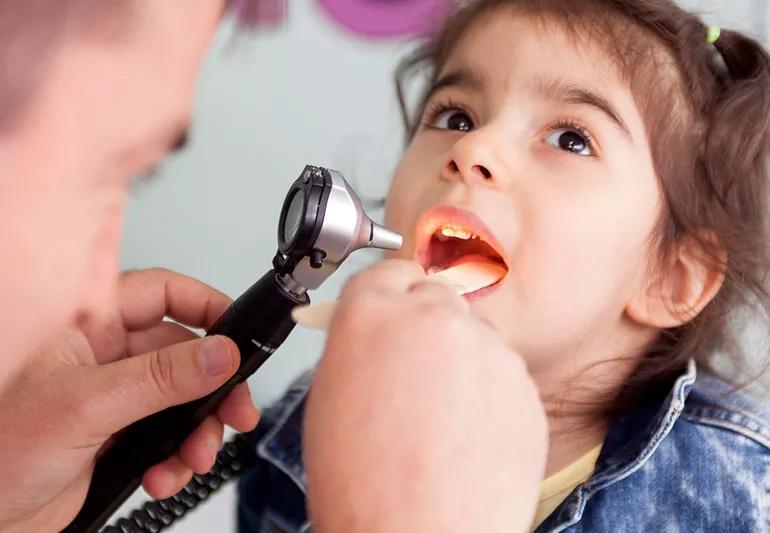The reasons for this common surgery

Tonsils, those two clusters of tissue in the back of the throat and their counterparts, the adenoids, are located just behind the nose. Their purpose is to help filter out harmful bacteria and viruses that are breathed in, protecting the body from infection. (Although adenoids typically shrink by age 7, and are virtually nonexistent by the teen years). But for some children, they are more trouble than they’re worth.
Advertisement
Cleveland Clinic is a non-profit academic medical center. Advertising on our site helps support our mission. We do not endorse non-Cleveland Clinic products or services. Policy
Pediatric otolaryngologist Rachel Georgopoulos, MD, says the most common reasons for removal — a tonsillectomy and/or adenoidectomy — are recurring throat infections and airway obstruction. (While doctors do these procedures mostly on children, some adults also opt for them as well, she says.) Here’s what often happens:
Some children have larger tonsils and adenoids than others, and they sometimes interfere with breathing. This is a problem particularly at night because the body is in a reclined position. It can cause a serious health condition known as sleep apnea — short periods of time when breathing stops during sleep.
If a child has severe sleep apnea, Dr. Georgopoulos says she will also perform an endoscopy prior to the tonsillectomy/adrenalectomy to do a thorough evaluation of the child’s airway while they are sleeping.
“Symptoms of sleep apnea in children can include snoring at least four nights out of seven, pauses in breathing followed by a ‘catch-up’ breath, restless sleep, sweating, tiredness and even bed wetting,” says Dr. Georgopoulos.
The effects of poor sleep also carry over into the waking hours. Children may show restless or erratic behavior, irritability and poor coping skills. “Removing tonsils and adenoids to help correct airway obstruction is so effective that many patients no longer experience sleep apnea,” she says.
Advertisement
“For children 3 and older, the surgeon usually removes both tonsils and adenoids. On occasion we will address tonsils in children younger than 2, and we will do what is called an intracapsular tonsillectomy, which is partial removal of the tonsil tissues,” she says.
Recurring throat infections mean defenses can’t keep up. Tonsils help keep bacteria and viruses out but, because they are one of the body’s first lines of defense, they are sometimes overwhelmed and infected themselves.
If your child has frequent throat infections (like strep throat) that include a fever and swollen lymph nodes lasting for three or four days, talk with your doctor about whether a tonsillectomy and adenoidectomy would help.
“Frequent” means:
Surgery to remove tonsils and/or adenoids is usually well-tolerated, with most children going home a few hours later. Tylenol® or ibuprofen help manage pain, and patients usually recover in seven to 10 days, says Dr. Georgopoulos.
She adds that surgery sometimes also helps with:
The good news is that surgeries to remove tonsils and adenoids are among the most common outpatient pediatric surgeries — and most children recover quickly.
Advertisement
Learn more about our editorial process.
Advertisement

The emergency room is for serious medical issues; urgent care can help when you can’t get a quick appointment with your child’s doctor

If your nose is constantly running, it could be allergies, chronic sinusitis, nasal polyps or other concerns

Gripe water isn’t regulated by the FDA, and research doesn’t support its use

Options like fatty fish, citrus fruits and sunflower seeds can help keep you well and heal faster

Lice don’t jump — but they can spread with direct head contact

Eat your fill of vitamins C, B6 and E, plus zinc and selenium

Some warts will clear up on their own, but others may need home remedies or medical care

Neti pots can be useful for sinus pressure relief and removing excess mucus

Start having sex about 72 hours before ovulation, then at least every other day during your fertile window

Attachment theory suggests that your earliest relationships shape connections throughout your life

It isn’t a recognized mental health disorder, but research shows that problematic social media use can negatively affect your mental health, self-esteem and sleep